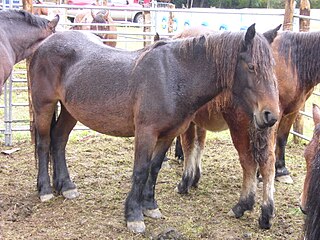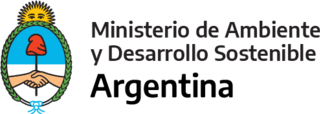
El Salvador is a country in Central America. Situated at the meeting point of three tectonic plates, it is highly seismologically active and the location of numerous earthquakes and volcanic eruptions. The country has a tropical climate.

Phytolacca icosandra, sometimes known as button pokeweed or tropical pokeweed, is a species of flowering plant found in the neotropics and introduced into the warmer areas of the western USA.

The Sayaguesa is an endangered Spanish breed of domestic cattle. It is named for the comarca of Sayago in the province of Zamora, in the western part of the autonomous community of Castilla y León, and is raised almost exclusively in that area. It may also be known as the Zamorana, the Moles de Sayago or the Castellana variedad Sayaguesa. It was traditionally kept mainly for draught work, but is now raised principally for meat.
The Angachilla River is a river of Chile. The river and the wetland of the same name drains toward Valdivia River to which it connects near San Ramón Peninsula. The southern peripheral neighborhoods of Valdivia reaches the revier.

The Catalan is a breed of large domestic donkey from the historic region of Catalonia, now in north-eastern Spain and south-western France. Approximately 80% of the breed population is in the modern autonomous community of Catalonia, and approximately 20% is in the historic Roussillon region of France.

The Rubia Gallega, Galician: Rubia Galega, is a breed of cattle native to the autonomous community of Galicia in north-western Spain. It is raised mainly for meat. It is distributed throughout Galicia, with about 75% of the population concentrated in the province of Lugo. The coat may be red-blond, wheaten, or cinnamon-coloured.

Montecristo National Park is a large national park centered on the Montecristo cloud forest in Mesoamerica. Montecristo National Park is located in the north-western tip of El Salvador, a country in Central America known for its wildlife diversity.

Pinguicula, commonly known as butterworts, is a genus of carnivorous flowering plants in the family Lentibulariaceae. They use sticky, glandular leaves to lure, trap, and digest insects in order to supplement the poor mineral nutrition they obtain from the environment. Of the roughly 80 currently known species, 13 are native to Europe, 9 to North America, and some to northern Asia. The largest number of species is in South and Central America.

The Jaca Navarra, or Navarrese Horse, is a Spanish breed of small horse from the autonomous community of Navarre in the north-eastern part of the country. In 2013 it was listed in the Catálogo Oficial de Razas de Ganado de España in the group of autochthonous breeds in danger of extinction. The total population of the Jaca Navarra has been variously estimated at 350, 250, and 240 and decreasing. In April 2011 the total population was reported to be 899, all of which were in Navarre. In 2000, and again in 2007, it was listed by the FAO as endangered.

The playa de Los Lances is a beach that forms one side of the town of Tarifa, in the region of Campo de Gibraltar in Andalusia, Spain.

The Loma de León Natural Monument Also Loma de León Is a natural protected area located in the municipality of Iribarren, belonging to the state of Lara, Venezuela. It received the status of national monument on February 2, 1987.
The Unellez Botanical Garden Is a botanical garden and a zoo of 14 ha of extension, located inside the facilities of the National Experimental University of the Llanos Ezequiel Zamora in Barinas, Venezuela. It is a member of the BGCI, being its international identification code as a botanical institution as well as s It is located to the northwest of the city of Barinas, at the foot of the Mountain range of the $ andes; To a height of 200 msnm and presenting an average annual temperature of 28 °C.

The La Laguna Zoo Also Zoological Park of La Laguna Is a zoological garden located in the town of Capacho Nuevo, near the city of San Cristóbal, in the Municipality Independencia of the State Táchira, in the Andes to the west of the South American country of Venezuela.

The La Guaricha Zoo Also Zoological Park of La Guaricha Is an urban zoo located less than 400 meters from the center of the city of Maturín, Monagas in Venezuela with native species of the region and the rest of Venezuela. The Municipality of Maturín maintains the rectory of the park and the Governorate of Monagas state assumes some administrative responsibility to support the programs that are developed in him.

The Spanish Trotter, Spanish: Trotador Español, is the national breed of trotting horse of Spain. It is reared almost exclusively in the Balearic Islands in the Mediterranean, predominantly in the island of Mallorca, but also in Menorca and Ibiza.

The Ministry of the Environment and Sustainable Development of Argentina was a ministry of the national executive power that oversaw the government's policy on environmental issues and promotes sustainable development.

Pico de Tancítaro, also known as Volcán Tancítaro, is a volcanic mountain in Mexico. It is located in Tancítaro municipality in Michoacán state. It is the highest peak in Michoacán.
















